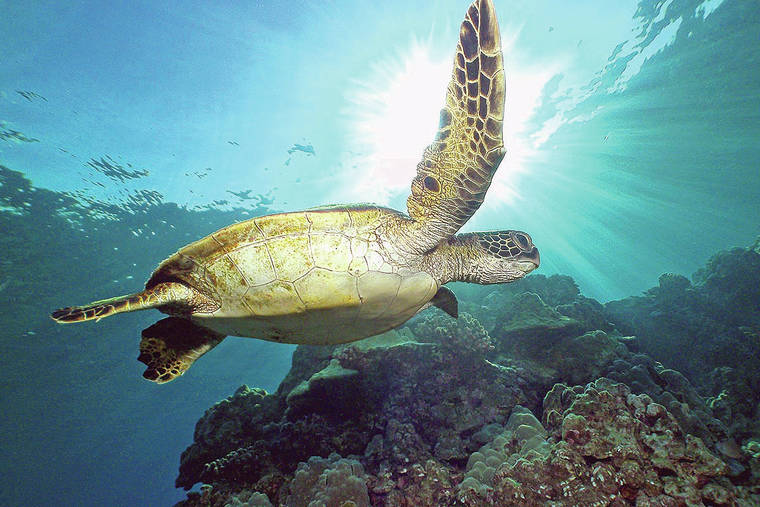LIHUE — Several organizations are gearing up to try to force the federal government to better protect green sea turtle habitat.
The Center for Biological Diversity, Sea Turtle Oversight Protection, and Turtle Island Restoration Network filed a notice of intent to sue Tuesday, citing a need to address sea level rise, plastic pollution and warming in areas where the turtles breed and live.
All green sea turtle populations are listed as either endangered or threatened under the federal Endangered Species Act, depending on the distinct population segments or their range within the U.S. jurisdiction.
“The recovery of most green sea turtle populations is a beacon of hope in our changing oceans, but we’ve got to protect the places they live,” said Jaclyn Lopez, Florida director for the Center for Biological Diversity. “Protecting sea turtle habitat will keep them crossing oceans and loyally coming ashore to dig nests on our beaches.”
The notice points to a 2016 study by the National Marine Fisheries Service Fish and Wildlife Service which found growing climate change and sea-level-rise threats mean the turtles remain threatened and still need ESA protection.
In Hawaii, researchers are keeping a particularly close eye on beach conditions this summer following the 2018 flooding of East Island, a critical sea turtle nesting site.
A hurricane crossed directly over the remote island on Oct. 3 and 4, 2018. Nesting season for the population in the Hawaiian Islands is generally in the late summer and was just ending when the hurricane hit.
Kauai usually has a few reports of nests during the season, but the Hawaii population nests primarily in the French Frigate Shoals of the Northwestern Islands, within the Papahanaumokuakea Marine National Monument.
Threats in the area include diminishing nesting grounds due to sea level rise, changes in ocean temperature, and marine debris that can entangle the turtles. Plastic bags that look like the turtles’ jellyfish prey are among the threats impacting the turtles.
Despite those threats — particularly to low-lying nesting beaches — the Center for Biological Diversity and partner in the potential lawsuit say agencies failed to protect the turtle’s critical habitat under the ESA.
The letter of intent specifically requests NMFS to propose critical habitat for each of the different green sea turtles’ distinct population segments, and to finalize rules for those habitat areas.
The letter also provides NMFS 60 days to start the critical habitat designation process, and says the organizations may pursue litigation in federal court if that doesn’t happen.
“Coastal nesting beaches are losing suitable nesting habitat due to sea level rise, as well as increased temperatures, which further jeopardizes the survival of green sea turtle,” said Richard Whitecloud, founding director of Sea Turtle Oversight Protection. “It is the government’s responsibility to protect this essential habitat to ensure these marine turtles survive.”
•••
Jessica Else, environment reporter, can be reached at 245-0452 or jelse@thegardenisland.com.



